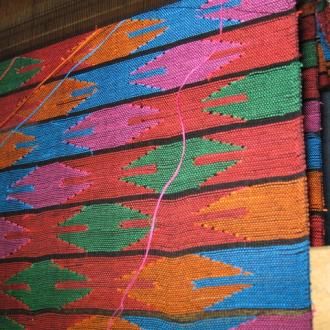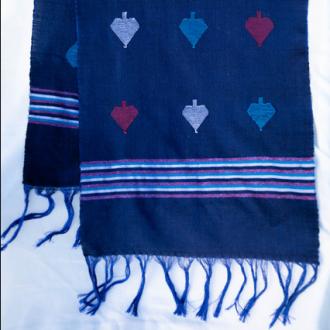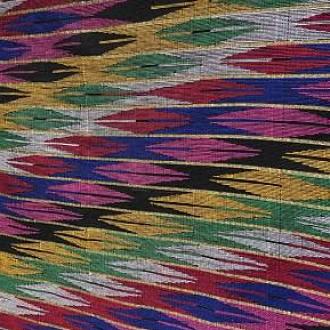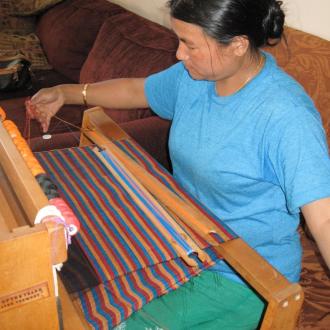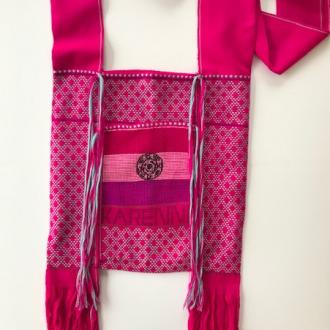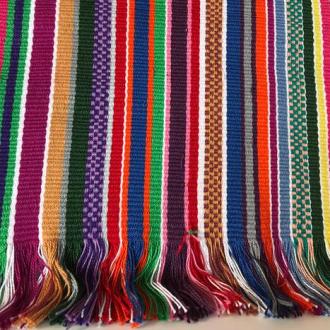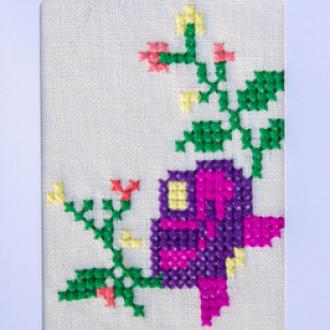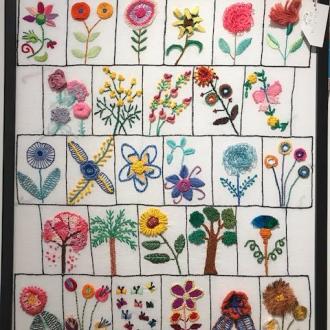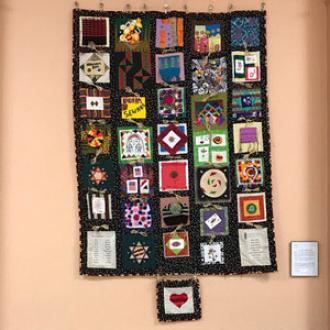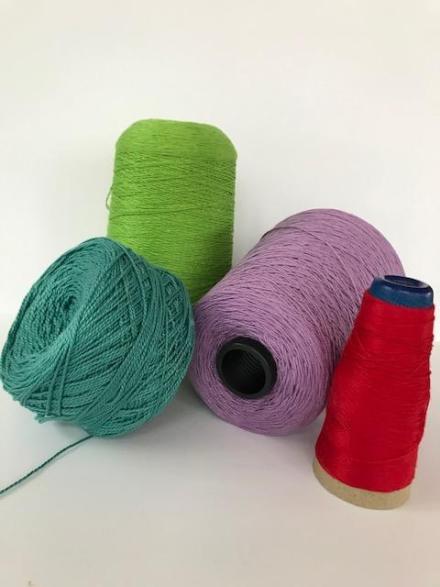
Mercerized Cotton Thread
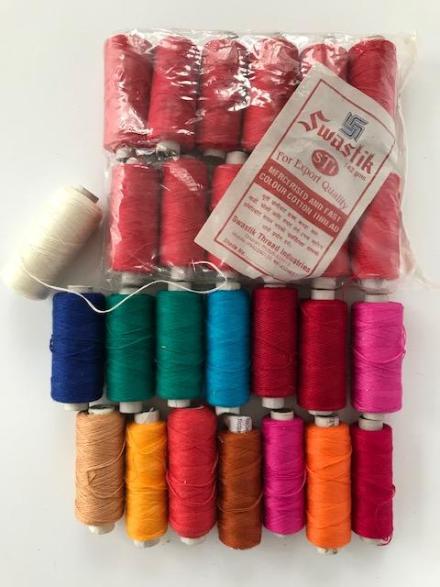
Cotton Thread from Nepal
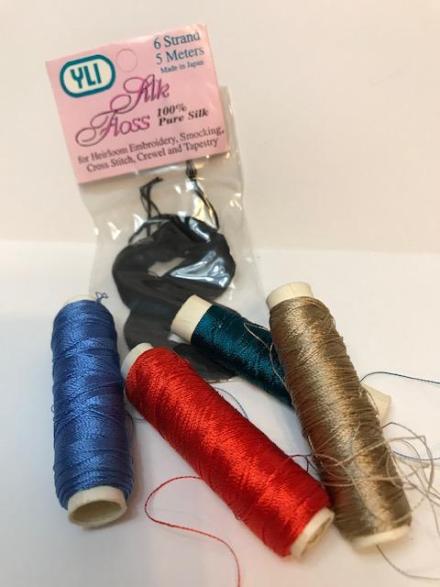
Silk Thread
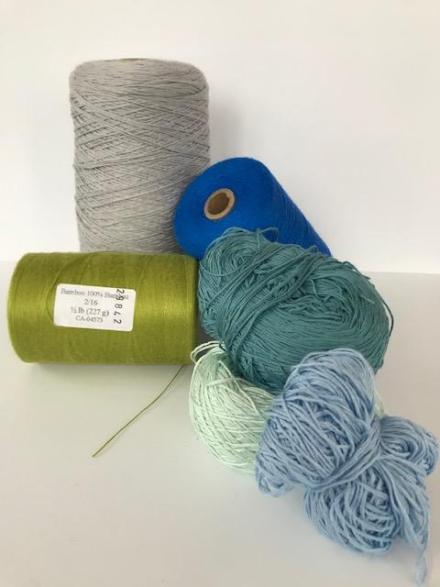
Bamboo Fiber
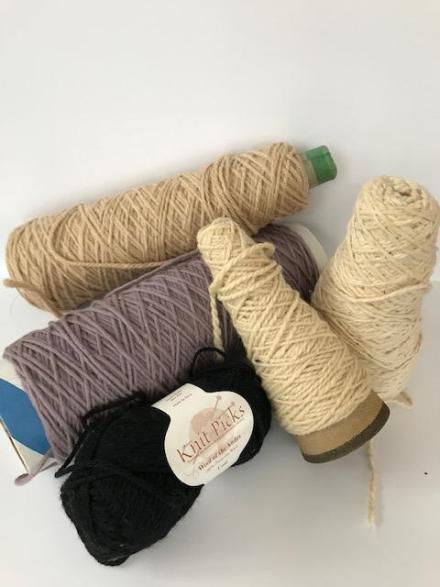
Wool Yarn
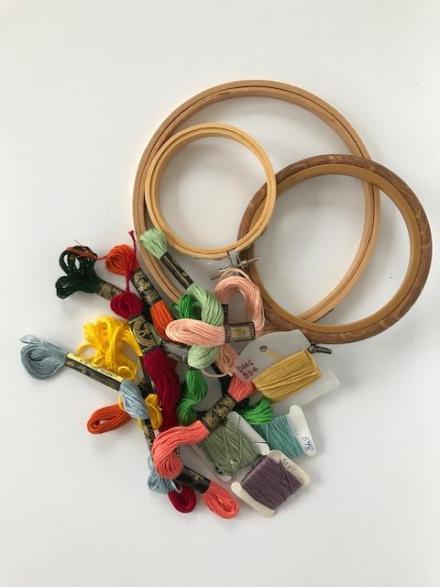
Embroidery Floss
The RAW artisans who weave textiles on back strap or upright frame looms and also the embroiderers who decorate cloth with all manner of elaborate, colorful stitchery have many types of thread to choose from in central Massachusetts sewing stores and hobby shops, However, most of them tell Ellen and Joan that they vastly prefer the “better” thread of their home regions. Thread from Nepal is shinier and more pliable for weaving work (they assert). Embroidery thread from Afghanistan markets also has these same qualities in contrast to commercial American thread, some artisans claim. So, whenever possible, Ellen and Joan do source the crafters’ threads from the countries they designate (via a combination of asking travelers to buy threads for RAW there, or leaning on the kindness of crafts people’s relatives in countries of origin to mail packages of threads to Worcester). Some artisans are accommodating themselves to American threads.
The thread types that RAW artisans use are made of cotton, or silk, or bamboo fiber. Weavers or embroiderers choose their favorite thread type or types according to what they are used to, or ‘tradition,’ or from personal preference, on the part of some of the more creative crafters. Indeed some of the weavers are now venturing into the wilds of showy metallic threads available in Massachusetts hobby shops. Metallic threads are quite popular in RAW weaving circles.
Cotton Thread
Cotton Thread is a prime choice among weavers in the Nepali-speaking Bhutanese community in Worcester. Karen and Karenni weavers originally from Burma also often choose it. RAW provides their thread, ready-made and already dyed. A natural, botanical fiber, cotton grows in a boll or protective case. It has many seeds, which must be separated from the white, fluffy fibers before the cotton is spun into thread. Thus, the boost to industrial production when the cotton gin was invented in 1793; this device mechanically separates the seeds from the cotton. Among the advantages of cotton is that it is durable, soft, and has high breathability.
Cotton grows in tropical and sub-tropical areas of the world. For the plant to thrive it must have a long frost-free season. Cotton cultivation demands high water use. The biggest cotton producers today are India and China and indeed these two countries have ancient traditions of cotton cultivation and use. In India, for instance, cotton was intentionally harvested by the 5th century B.C.E.
Today, most commercially available cotton thread is mercerized. That is, the cotton has been treated with a caustic solution (sodium hydroxide) which stresses the fibers and causes them to swell. This gives them a silky, lustrous look when the process is complete. Cotton comes in shorter or longer fiber lengths; the longer ones are generally more expensive. In many regions of Asia weaving communities dye their own threads with natural dyes such as indigo. Cotton fibers are relatively hard to dye and often a mordant must be used, to allow the fibers to soak up hue and to guard against fading. The RAW artisans do not include mordanting or dyeing in their weaving work. The commercial dye colors they choose from include blue, black, red, green, yellow, white, purple, brown, lavender and pink.
Silk Thread
This is a remarkable fiber: both lustrous and tough, beautiful and shimmery but also full of practical uses (as undergarments, for instance). It is employed by some of the RAW embroiderers and by some Bhutanese weavers. Silk takes different fabric forms: as silk cloth per se but also as satin, chiffon, taffeta, crepe de chine, and shantung. China and India both have ancient traditions of silk cultivation and remain major producers today. Silk’s natural sheen explains some of the apparently universal desire for silk clothing, as a luxury item dating back to the heyday of the famous Silk Road from China to gateways to Europe.
Silk is a natural protein fiber produced in large part through the tiny industries of hundreds of insect larvae. The Mulberry silkworm (Bombyx mori) is the major player here: the sericulture farmer first grows the silkworms on mulberry leaves. As the insects munch away, they start pupating in cocoons. Most remarkably, they are in there spinning silk. The farmer then dissolves the mature cocoons in boiling water, which allows the extraction of the long fibers. Once dried these can then be fed into the spinning wheel, to make thread. This can then be dyed; silk takes up dye colors with relative ease. If one ever travels to Siem Reap, Cambodia, near the great Angkor temples, the social business Artisans d’Angkor offers wonderful step-by-step lessons on the entire silk making process, complete with live silkworms.
Bamboo Fiber
In the last several years some of the RAW weavers originally from Burma have become entranced with bamboo thread. When woven this makes for a soft, elegant, supple, breathable fabric, with a wonderful ‘hand’ when picked up. Bamboo fiber is a tree cellulose product made when bamboo leaves and the soft inner pith within the hard bamboo trunk are crushed together. This is then soaked in a natural enzyme solution. The resultant fibers are then washed and spun into yarn, which can be woven into textiles. Sometimes bamboo fiber is combined with cotton or wool fibers, or synthetic ones. Bamboo thread textiles have a high moisture content and are notably wicky, as Asian bamboo fiber sock production today indicates.
Wool Yarn
Wool Yarn is also in use by some of the RAW weavers and embroiderers. RAW’s one knitter, Nandi Guragai, produces a wealth of winter scarves, sweaters, and hats with two-ply wool yarn. RAW helps him procure his yarns from local crafts shops; he likes the two-ply type since it yields a denser, more tightly woven product. He learned to knit back in Bhutan.
Embroidery Thread, or Embroidery Floss
Embroidery Thread, or Embroidery Floss. Hand embroidery, an ancient craft, basically involves decorating a small or large piece of cotton cloth, linen or silk by working fancy stitches into designs on the cloth’s surface. Chain stitch embroidery onto silk cloth goes back thousands of years in China; India is also a longtime embroidery powerhouse, as are most all nations in the Middle East. European embroidery, imported to the Americas as well, is also formidable in technique and beauty. Embroidery work is often associated with girls and women and is used to denote her cleverness, diligence at close work, and readiness for marriage. Fancy stitches applied to wool cloth (crewel work) is another craft form found in Europe and the United States. Cross stitch embroidery is widespread. Many though not all embroiderers use a hoop or small frame to keep their cloth stretched taut. This is a technique used in needlepoint, in which threads are inserted in intricate patterns through a dense mesh.
In many countries with strong embroidery traditions, the craft is both a folk art done in homes and one that derives in part from the stitchery work of professional guilds, employed in workshops often associated with wealthy elites or royal families. The famous Bayeux Tapestry, which narrates the Norman Conquest of Britain, is actually a long, story-board sort of embroidery, commissioned by a wealthy benefactor.
The wide array of embroidery thread in a profusion of attractive colors has helped to fuel a reemergence of the craft since about 2010. The RAW artisans’ work is a small part of this worldwide phenomenon. Many of the RAW embroiderers originally from Afghanistan, Iraq, and Syria choose six-stranded cotton floss, which can be pulled apart if a crafter so prefers. RAW buys their thread from craft stores augmented very generously by donations from Michael’s and C.C. Lowell (Worcester-area shops). Sometimes embroiderers employ two-stranded floss of special types to add extra shininess or texture. A blended metallic-looking thread can also be used; similarly, an artisans can choose to employ silk embroidery thread. When making inserts for greeting cards for sale through RAW crafters often choose bright, eye-catching colors to make their little panels stand out.
